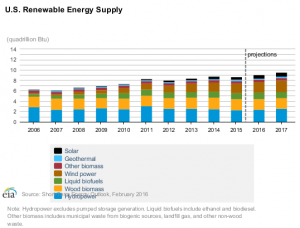Source: http://www.eia.gov/forecasts/steo/report/renew_co2.cfm
Electricity and Heat Generation from Renewables
EIA expects total renewables used in the electric power sector to increase by 8.1% in 2016. Forecast hydropower generation in the electric power sector increases by 3.6% in 2016.
Liquid Biofuels
On November 30, EPA finalized a rule setting Renewable Fuel Standard (RFS) volumes for 2014 through 2016. EIA used these finalized volumes to develop the current STEO forecast and assumes the 2016 targets for 2017, except the biomass-based diesel 2017 target of 2.0 billion gallons that was included in the November 30 rule. Ethanol production averaged an estimated 965,000 b/d in 2015, and it is forecast to average close to that level in both 2016 and 2017. Ethanol consumption averaged 910,000 b/d in 2015, and it is forecast to average more than 920,000 b/d in both 2016 and 2017. This level of consumption results in the ethanol share of the total gasoline pool averaging 10.0% in both 2016 and 2017. EIA does not expect significant increases in E15 or E85 consumption over the forecast period.
EIA expects the largest effect of the proposed RFS targets will be on biodiesel consumption, which helps to meet the RFS targets for use of biomass-based diesel, advanced biofuel, and total renewable fuel. Biodiesel production averaged 84,000 b/d in 2015 and is forecast to average 107,000 b/d in 2016 and 112,000 b/d in 2017. Net imports of biomass-based diesel are expected to rise from 28,000 b/d in 2015 to 47,000 b/d in 2016 and to remain at that level in 2017.
Energy-Related Carbon Dioxide Emissions
EIA estimates that emissions of CO2 declined by 2.2% in 2015. Emissions are projected to increase by 0.5% in 2016 and by 0.5% in 2017. These forecasts are sensitive to assumptions about weather and economic growth.

